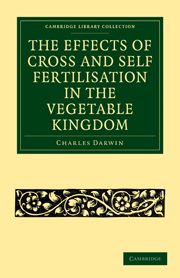Book contents
- Frontmatter
- Contents
- CHAPTER I INTRODUCTORY REMARKS
- CHAPTER II CONVOLVULACEÆ
- CHAPTER III SCROPHULARIACEÆ, GESNERIACEÆ, LABIATÆ, ETC
- IV CRUCIFERÆ, PAPAVERACEÆ, RESEDACEÆ, ETC
- CHAPTER V GERANIACEÆ, LEGUMINOSÆ, ONAGRACEÆ, ETC
- CHAPTER VI SOLANACEÆ PRIMULACEÆ, POLYGONEÆ, ETC
- CHAPTER VII SUMMARY OF THE HEIGHTS AND WEIGHTS OF THE CROSSED AND SELF-FERTILISED PLANTS
- CHAPTER VIII DIFFERENCE BETWEEN CROSSED AND SELF-FERTILISED PLANTS IN CONSTITUTIONAL VIGOUR AND IN OTHER RESPECTS
- CHAPTER IX THE EFFECTS OF CROSS-FERTILISATION AND SELF-FERTILISATION ON THE PRODUCTION OF SEEDS
- CHAPTER X MEANS OF FERTILISATION
- CHAPTER XI THE HABITS OF INSECTS IN RELATION TO THE FERTILISATION OF FLOWERS
- CHAPTER XII GENERAL RESULTS
- INDEX
CHAPTER IX - THE EFFECTS OF CROSS-FERTILISATION AND SELF-FERTILISATION ON THE PRODUCTION OF SEEDS
Published online by Cambridge University Press: 29 August 2010
- Frontmatter
- Contents
- CHAPTER I INTRODUCTORY REMARKS
- CHAPTER II CONVOLVULACEÆ
- CHAPTER III SCROPHULARIACEÆ, GESNERIACEÆ, LABIATÆ, ETC
- IV CRUCIFERÆ, PAPAVERACEÆ, RESEDACEÆ, ETC
- CHAPTER V GERANIACEÆ, LEGUMINOSÆ, ONAGRACEÆ, ETC
- CHAPTER VI SOLANACEÆ PRIMULACEÆ, POLYGONEÆ, ETC
- CHAPTER VII SUMMARY OF THE HEIGHTS AND WEIGHTS OF THE CROSSED AND SELF-FERTILISED PLANTS
- CHAPTER VIII DIFFERENCE BETWEEN CROSSED AND SELF-FERTILISED PLANTS IN CONSTITUTIONAL VIGOUR AND IN OTHER RESPECTS
- CHAPTER IX THE EFFECTS OF CROSS-FERTILISATION AND SELF-FERTILISATION ON THE PRODUCTION OF SEEDS
- CHAPTER X MEANS OF FERTILISATION
- CHAPTER XI THE HABITS OF INSECTS IN RELATION TO THE FERTILISATION OF FLOWERS
- CHAPTER XII GENERAL RESULTS
- INDEX
Summary
The present chapter is devoted to the Fertility of plants, as influenced by cross-fertilisation and self-fertilisation. The subject consists of two distinct branches; firstly, the relative productiveness or fertility of flowers crossed with pollen from a distinct plant and with their own pollen, as shown by the proportional number of capsules which they produce, together with the number of the contained seeds. Secondly, the degree of innate fertility or sterility of the seedlings raised from crossed and self-fertilised seeds; such seedlings being of the same age, grown under the same conditions, and fertilised in the same manner. These two branches of the subject correspond with the two which have to be considered by any one treating of hybrid plants; namely, in the first place the comparative productiveness of a species when fertilised with pollen from a distinct species and with its own pollen; and in the second place, the fertility of its hybrid offspring. These two classes of cases do not always run parallel; thus some plants, as Gartner has shown, can be crossed with great ease, but yield excessively sterile hybrids; while others are crossed with extreme difficulty, but yield fairly fertile hybrids.
The natural order to follow in this chapter would have been first to consider the effects on the fertility of the parent-plants of crossing them, and of fertilising them with their own pollen; but as we have discussed in the two last chapters the relative height, weight, and constitutional vigour of crossed and self-fertilised plants—that is, of plants raised from crossed and self-fertilised seeds—it will be convenient here first to consider their relative fertility.
- Type
- Chapter
- Information
- Publisher: Cambridge University PressPrint publication year: 2009First published in: 1876



